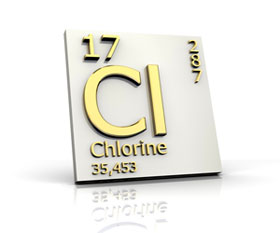
WATER DISINFECTION METHODS, PART II
VARIOUS CHEMICAL DISINFECTANTS

The most common method of treating water for contamination is to use one of the various chemical agents available. Among these are chlorine, bromine, iodine, potassium permanganate, copper and silver ions, alkalis, acids, and ozone. Let us review them briefly here.
BROMINE
Bromine is an oxidizing agent that has been used quite successfully in the disinfecting of swimming pool waters. It is rated as a good germicidal agent. Bromine is easy to feed into the water and is not hazardous to store. It apparently does not cause eye irritations among swimmers, nor are its odors troublesome.
CHLORINE
One of the most widely used disinfecting agents to ensure safe drinking water is chlorine. Chlorine in cylinders is used extensively by municipalities in water disinfection. However, in this form, chlorine gas (Cl2) is far too dangerous for any home purposes.
For use in the home, chlorine is readily available as sodium hypochlorite (household bleach) which can be used both for laundering or disinfecting purposes. This product contains a 5.25% solution of sodium hypochlorite which is equivalent to 5% available chlorine.
Chlorine is also available as calcium hypochlorite, which is sold in the form of dry granules. In this form, it is usually 70% available chlorine. When calcium hypochlorite is used, this chlorinated lime should be mixed thoroughly and allowed to settle, pumping only the clear solution. For a variety of reasons, not the least of which is convenience, chlorine in the liquid form (sodium hypochlorite) is more popular for household use. Chlorine is normally fed into the water with the aid of a chemical feed pump.
The first chlorine fed into the water is likely to be consumed in the oxidation of any iron, manganese, or hydrogen sulfide that may be present. Some of the chlorine is also neutralized by organic matter normally present in any supply, including bacteria if present. When the "chlorine demand" due to these materials has been satisfied, what's leftover - the chlorine that has not been consumed - remains as a "chlorine residual."
Chlorine. There are three basic terms used in the chlorination process:
- chlorine demand,
- chlorine dosage and
- chlorine residual.

